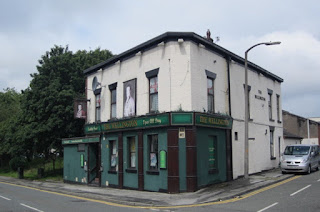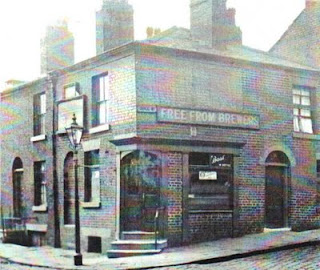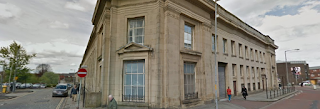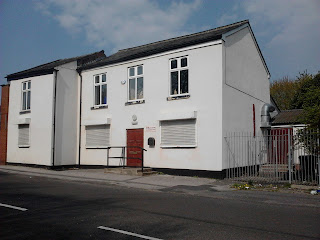A 2002 view of the pub can be seen here. [1]
The Wellington Inn was situated at number 51 Bury New Road,
Bolton.
The pub was on the edge of the densely-populated and
heavily-pubbed Mill Hill district just a few hundred yards away from the town
centre, but in the opposite direction was Castle Street, Dorset Street and rows
of more desirable terraced housing. As this area of Bolton was developed in the
late-nineteenth century it attracted a better class of punter than the older
housing in Mill Hill and it was perhaps with these streets in mind that the
Wellington obtained a full licence as opposed to the beer-house licenses that
were prevalent in Mill Hill.
The Wellington was certainly in existence by 1871and was
probably there some years earlier. Worrall's Directory for that year notes William Stubbs as the brewer there.
It was owned for much of its existence by the Crown Brewery of Bury. Crown had a number of pubs in Bolton: the Man and Scythe on Churchgate and another Wellington, the one on Market Street in Farnworth, to name but two. Crown and its 127 pubs was taken over by Dutton’s of Blackburn in 1959, but Dutton’s sold out to Whitbread in 1964 and the Wellington spent the next 30 years or so under Whitbread ownership.
It was owned for much of its existence by the Crown Brewery of Bury. Crown had a number of pubs in Bolton: the Man and Scythe on Churchgate and another Wellington, the one on Market Street in Farnworth, to name but two. Crown and its 127 pubs was taken over by Dutton’s of Blackburn in 1959, but Dutton’s sold out to Whitbread in 1964 and the Wellington spent the next 30 years or so under Whitbread ownership.
In 2010, the Wellington was bought by Pritesh Chauhan who
spent £10,000 on re-decorating the pub. A function room was created and a big
screen installed in time for the 2010 World Cup. Pritesh’s family helped out on
the food side. He got a couple of good write-ups in the Bolton News and on the
Best Of Bolton website but sadly the venture failed to take off.
In late-2012 the Wellington was put up for auction but was
bought before it went under the hammer by the owner of Nash’s Pharmacy on
Castle Street. It appeared on the list of 12 Bolton pubs to close in 2013
although Bolton Council’s spreadsheet of empty properties showed that it was vacated just before Christmas 2012.
Planning permission was lodged in April 2013 for the
Wellington to be turned into ground-floor offices and six two-bedroom flats and
this was granted in September 2013.
[1] Bolton.org.uk
Retrieved 29 April 2014.
The picture below shows the Wellington during its conversion into flats, April 2014. An extension was being added to the rear of the pub to help accommodate some of its six two-bedroomed flats.





























